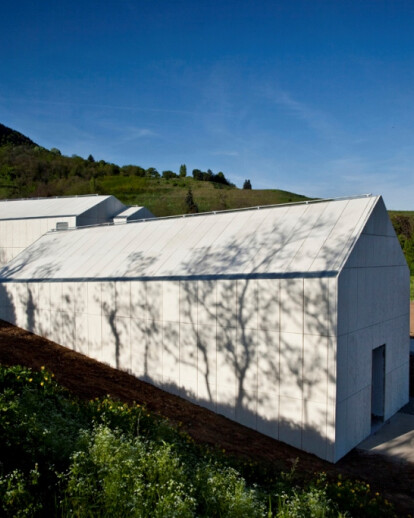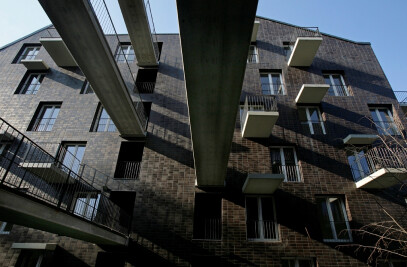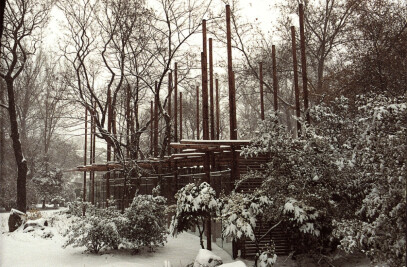Basalt Wine - Laposa Cellar, Processing building Badacsonytomaj, land registration number: 017/8
Introduction
The Witness Hills The Witness Hills illustrate the original height of the previously eroded and weathered area. These hills do not form a chain, but are solitary islands that stand alone preserving a specific stratification that arose from the former Pannon sea. Millions of years ago at the deepest part of the Pannon Sea that covered the Balaton Highland and the entire territory of the country, violent volcanic activity took place. The famous hills of the Balaton Highland: Badacsony, Szent György-Hill, Csobánc, Gulács, the Tóti Hill, Haláp, as well as a little further north from these, arising from the plain, the Somló-Hill, the Kis-Somló and the Ság-Hill were all the result of these volcanic activities that interrupted the limestone sediments As the burning lava erupted to the surface through the cracks resulting from crustal movements, it soon solidified, covering and protecting like an armour the sandy-clay island hills hiding beneath. These heights have resisted both wind and ice due to this basaltic armour, and stand witness even today to the height of the “original” land surface.
The Badacsony Basalt Badacsony is the highest southern Witness Hill in the Tapolca-basin, rising between two bays of Lake Balaton. The circumference of the nearly round hill is 11 km and the diameter of its plateau region that is slightly elongated in a north-south direction is 1-1.5 km. The highest peak stands at 437.4 m above sea level. Up to a height of 280 meters the side is covered by varying loose sediments, mainly the remaining layers of volcanic debris, eroded from the slopes of the foothills. Above this grey basalt, cliffs and stone screes emerge from the thick covering of the forest. The steep regions between the base of the hills and upper regions have often been transformed into terraces, as the loamy basalt debris is not only excellent for growing vines but also provides the body and rich mineral aromas of the wines with their beautiful acid background characteristic of this landscape.
Lake Balaton The other important natural characteristic of the area is the sub-Mediterranean micro climate. On the southern, south-western sunny slopes that are topographically protected from the north, the favourable effect of Lake Balaton can also be felt: the large water surface of the lake prevents the development of extreme temperatures, as well as ensuring higher humidity content in the air. Thus as a result of the even temperature free of extremes the summers are not too hot and the winters lack harshness: as a result, the vineyards do not suffer from frost damage and due to the plentiful and partially reflected sunshine, the high acid content of the wines is accompanied by high sugar and/or alcohol content.
The grape and the wine White grapes are mainly being grown in the Badacsony wine growing region, mostly the Olaszrizling, Szürkebarát and Kéknyelű grapes– with these varieties producing the most beautiful of wines. The wine of the grey monks from a grape variety of French origin, the Pinot Gris, has been raised to a local speciality for over 600 years. The berries of the Szürkebarát are purple when ripe with the wine being light golden in colour. Its taste, if made dry, is spicy and medicinally herby. In special years the berries shrivel and can become virtually raisins on the vine, resulting in a deep and complex almost sherry type wine. The Kéknyelű variety is virtually exclusive to this wine growing region in Hungary. It is rarely planted on its own as it carries female flowers and is a poor pollinator, thus vines are mixed with the Budai zöld variety. At harvest it is not picked separately and is processed together being sold under the Kéknyelű name. The wine has a light green colour and a restrained but characteristic aroma; its acid balance is best enjoyedfollowing a long maturation.
The Press Houses Between the vineyards and the retaining walls built from basalt rocks cellars and press houses have been built for centuries providing a home for both wine making and relaxation. Enclosed rooms were built in front of and also above these small subterranean maturation spaces, operating on the one hand as an entrance for the cellars with their unchanging temperature, and on the other the processing of the grapes took place here. The small scale, simple shaped and structured (press) house archetypes provided a specific character to the vine covered hills with their “illuminated” facades.
The descriptions in the Introduction were prepared by using materials from the following institutes: Balaton Highland National Park, Independent Ecological Centre, Hévíz-Info, Zrinyi Miklós Secondary School – Zalaegerszeg, Hungarian Wine Guide.
Architecture The wines of the Laposa-Cellar following the millennium became well known amongst Hungarian wine drinkers under the brand name “Bazaltbor” or Basalt wine. Their growing regions are only on the basalt hills – in Badacsony, Somló, on Szentgyörgy-hill and Csobánc – which is the reason for the characteristic mineral aromas of the wines that mirror their terroir. The cellar today harvest from over 20 hectares local and international varieties, amongst others Szürkebarát, Juhfark, Olasz- and Rajnai Riesling or Kéknyelű. The market entry and dynamic growth of the cellar has also resulted in the expansion of the technological and tourism areas. During the development, besides increasing the scale, the aim on both an architectural and viticultural level was to modernise and maintain the making and presentation of the basalt wine. The wine making activity moved down to the foot of the hill, to Badacsonytomaj, from the previous family cellar that operated in the southern side of Badacsony. With the freeing up of the old winery, a catering / tasting section and in connection with this also a small hotel will be built on the site emphasising the extraordinary panorama of Lake Balaton that opens up from there. The upper regions, which serve vine growing as well as relaxation, and the lower viticultural processing plant become connected by the revitalisation and recultivation of the vine regions of the hillside. In addition, the wine route or educational path to be built will also present this organic relationship. The entire region is part of the Balaton Highland National Park, whilst however the upper section of the wine route belongs more to the natural landscape (as well as to the cultivated and terraced vineyard hillsides), the processing building on the lower site form part of the single level free standing style of the town. Whereas the urbanising process is only characteristic of recent decades, in general the viticulture of the Balaton Highland, (fundamentally rooted in its character, by its nature,”) has to connect more with nature. An important question then is with what formal method can the building which is of a relatively large-scale compared with its environment be managed. The single reference point can only be the earthbound architecture of the vine (the press house and the retaining wall) as well as nature itself. Being bound to the earth as a result of the programme should be taken literally: building shall take place downwards along the gravitational principle, so that the grapes are exposed only to the most necessary procedures. This way only a quarter of the total area of the vinery is above ground, the rest is contained in the belly of the hill. On this basis we cannot work with architectural tools, forms, structures and clear archi(tectonic) matches in a traditional sense, but at the same time we cannot reject them entirely either. The viticultural building has to be like a model, but the hierarchic organisational structure is not an exclusive factor for this. In the geometric model two basic elements – the symmetric gable, closed roof abstraction of the press house and the hexagonal shaped idealised cross section of the basalt pillars-layers – connect together into a new system, which at the same time is also a reminder of both references. The basic elements – as the basalt bands that erupted to the surface – run freely, in any direction where there are no obstacles; sometimes separating, sometimes joining. The dimensions of the geometrical basic elements (cross sections) are variable, thus flowing into each other, in places rising from the soil and providing a distorted surface on the roof. The building is composed of connected panel elements, which were cast as monolithic visible concrete. The neutrality and rigidity of this is primarily detectable in the internal spaces and their relationship. There were two places where the dressing of the model, thus the addition of secondary ornamentation was necessary: when meeting the outside and at the cellar section for barrel maturation. For the former, following the principle of being like a model, the differentiation of the facades and the roof is missing; their homogenous covering is made up of prefabricated fine concrete facing panels, with a slightly transformed pattern of grapevines climbing and twining around them. If natural lighting needs to be provided in the inside spaces, the bands in the reinforced concrete model, following its geometry, were replaced by a light structure and glass cladding and the facing panel by a perforated metal sheet. Naturally the same grapevine pattern continues on this latter one, pulling it together into a unified surface. The other ornament is to be found in the inside, in the deepest branch of the cellar. Although this space is of a longitudinal nature with a barrel shape, like a traditional cellar, its axis is broken several times and its structure is from reinforced concrete as part of the model. This bent-broken surface is covered by a brick layer characteristic of traditional cellars, but not according to the principles of tectonic order and brick binding, but diagonally, appearing as a woven fabric.
Operation Inside of the model, the structural order and the sequence of the spaces follow the wine making process in both a vertical and horizontal sense. The processing building consists of a technological wing of more industrial nature and an integrally linked brick covered cellar wing with ripening / storage functions. The two parts at the same time are separated by the floor plan and really form the two wings of a building. The line of cellars is covered by a layer of soil which is over five metres thick, with only the entrance rising above ground level. Only one of the three levels of the technological wing is above ground, the remaining two are underground with access being provided to the cellar wing at the lowest level. According to the gravitational system, grape processing takes place at zero level, in the middle of the building, with connections at soil level: following selection and separation of the berries the grape is placed into the receiving containers or tanks that are sunk into the floor. From here it passes on to the mobile press which is usually a level beneath, then to one more level deeper, now in the form of must, into the fermentation steel containers or the fermentation and ripening barrels. This central section is two storeys high and also has a direct connection to the processing space above through a floor opening. The press moves on a gantry that is suspended in the airspace. The vertical transport core is also located in this large space with stairs and a freight elevator. In line with gravitation the red wine barrel maturation can be found on the lower level and the maturation barrels for white wines in the cellar wing. The wine exiting the barrels reaches the bottling room on the zero level through the developed pump system, where the wine returns to the deeper levels with the help of the freight elevator. There are four bottle maturation rooms available, differing in size and climate. At ground level there are two separate entrances in the technological wing for receiving the grape and for delivering bottles. The processing and labelling-storing space is accordingly behind them. The two-story reception area, which also houses bottle maturation in the southern direction and is linked to the cellar wing, also has entrances from the road and from Lake Balaton: guests who are also interested in the wine making itself are welcomed here. The unified consideration of the internal spaces is supported by the visible concrete cover, which in reality is independent of the functions taking place within it. The displayed furnishing is characteristically technological, thus objects (tanks) or lateral pipe fittings and matching lighting fixtures of an “industrial appearance” are uniformly made of stainless steel. All installations are made separately from the structure and assembled, with an alignment following the directions of the model geometry and the roof ridge. The slotted soak-away that runs along the building is also in line with this concept, it removes liquids from the solid, non-slip epoxy floor covering, which is easily cleaned but at the same time resistant to industrial and cleaning water as well as chemicals. Such secondary units, as the social block, the laboratory and the mechanical spaces are located on the top floor. The external air technology unit and the aggregated technological cooling system have been located close to the central core, although still outside and along the western wall, being at the same height as the internal level, but at the same time sunken compared to the ground.
Péter Kis, Bea Molnár
Client
Bazaltbor-Badacsony Kft.
planning
2008
construction
2009 május - 2010 május
Architects
Kis Péter Építészműterme Kft. www.plant.co.hu
Kis Péter, Molnár Bea
all photographs by Zsolt Batar

































